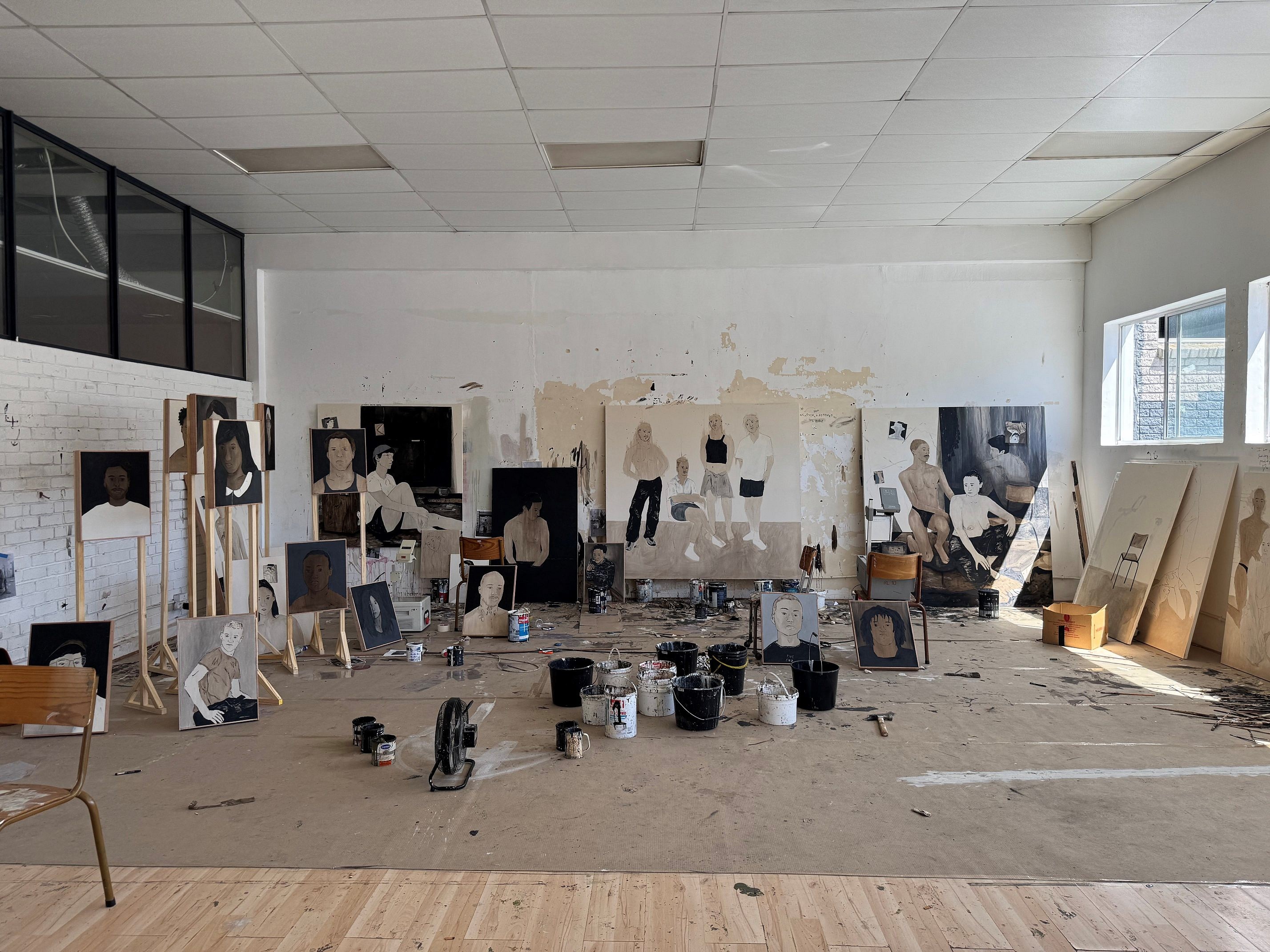PRESS RELEASE

BRETT CHARLES SEILER: I would like to lose it all with you
Feb 5 – Feb 26, 2025
I would like to lose it all with you, a solo exhibition by Brett Charles Seiler.
Opening reception: Wednesday 5th February - 6pm
CLICK HERE TO REQUEST A PORTFOLIO
On Brett Charles Seiler’s Enthralling Economy
By Sean O’Toole
The story of painting in South Africa is one of camaraderie and hustle, a rhythm of making and surviving that Brett Charles Seiler knows well. It is impossible to untangle his luminous biography as a painter from these circumstances. But painting’s story here in South Africa is also impersonal, a vast web of intersecting histories, where influence isn’t just absorbed, wrestled with, reconfigured, but also inherited. Historically, English and European painting – particularly in the revolutionary wake of Impressionism and the charge of Expressionism – has pressed its weight onto artists in South Africa.
And what of America? Its influence is palpable, just less so, hovering at the edges of the biographies of South African painters, sometimes explicitly, other times as a spectral influence. There are the teachers, the mentors: Bill Ainslie, a proponent of Ab Ex, and Robert Hodgins, whose admiration of Francis Bacon was upended by an encounter with Phillip Guston’s paintings. And then there is, less obviously, Brett. Over the years, Brett has returned to New York School poets like Joe Brainard and Frank O’Hara, their casual brilliance, their ability to make the daily and the tragic exist side by side.
“I am more interested in poets and photographers than I am in painters,” he remarked during a recent conversation. Brett reached for a book lying in his studio. Weight of the Earth (2018) collects transcripts of David Wojnarowicz’s tape journals from the later 1980s. “He just rambles,” Brett told me. “I love it, but I wish there was an audiobook.” Like Brett, Wojnarowicz was gay. And like Wojnarowicz, an incandescent figure in 1980s New York, Brett’s anything-goes approach to making and soft militancy sets him apart from his peers.
But this is not the only reason to linger on this fleeting moment from my studio visit. In 1987, Wojnarowicz photographed his former lover and mentor, Peter Hujar, at the moment of his death. His photographs are records of grief, a sorrow made possible by friendship, of knowing and loving someone deeply, both physically and platonically. Brett’s new exhibition, I would like to lose it all with you, finds similar succour in friendship. Similar? The title of his exhibition is an optimistic adaptation of a line from a plaintive 2023 song “The Party that Never Ends” by experimental pop band HeadAche, whose charged AI-narrated monologue mirrors Seiler’s frank sensitivities as a painter.
Brett’s new exhibition brings together 37 new paintings that further his painterly interest in portraiture as a site of artistic translation and conduit of emotion and memory. His subjects are friends, many incidentally trans and queer people, who visited his studio, among them artists Akshar Maganbeharie and Shakil Solanki. There are two portraits of Keenan, the tattooist and gin-slinger at a favoured Cape Town artists’ haunt, and a large painting of Koko and Aaron, high school lovers whom Brett met at a Lady Gaga concert in 2012 – the same year he arrived in Cape Town from Harare to study art.
It is possible to name his sitters if you like – “Oh look, there’s Rupert! That’s Masa Diamond! OMG!” – but recognition isn’t what energises his casually elegant paintings. While Brett’s paintings emerge from photographs they refuse the simplicity of documentation. They are not only or principally about likeness. “These are people I know,” Brett said, “but the paintings aren’t portraits in the traditional sense. They’re more about atmosphere and storytelling.” In his earlier works, when lovers Alec and Matty stood in as models, his figures felt anonymous, placed in floating voids or domestic scenes filled with bunting and delicious monsters. Now, his subjects have a specific presence, and his studio – a site of labour and a different kind of intimacy – is embedded in the work.
Brett’s District Six studio is littered with stacks of cheap printouts and plastic transparencies bearing spectral tracings of his candid photos and those appearing in magazines. This is the raw material of Brett’s paintings. The process of making a painting is iterative: a photo is traced onto transparency to fix proportions, details changed here or there, following which the line drawing is projected onto canvas, where it is further added to, erased, adjusted. “The end result is a kind of collage more than a portrait really,” Brett said. In his larger works, ghostly outlines of figures and references to older works that still hold meaning for him serve as marginalia – what Brett calls his “remarks.”
Known for his use of “humble materials” like bitumen and roof paint, Brett has framed these new works with industrial pine, presenting them on handmade plinths, off the wall. This economy of means – an attribute he shares with Wojnarowicz – is part and parcel of his minimalist approach. I don’t mean Minimalism minimalism, not in the rigid, formal sense, but a kind of distilled essence. His reduced palette of black and brown, the hues of cardboard and ink, forms a vital part of this painterly thrift and restraint. It is an enthralling economy. “It’s about pushing the materials I have, making the most with the least. It’s a step forward for me.”
Sean O’Toole is a writer, editor and occasional curator based in Cape Town.
He has published two books and edited three collections of essays.
Installation images by Michael Hall



